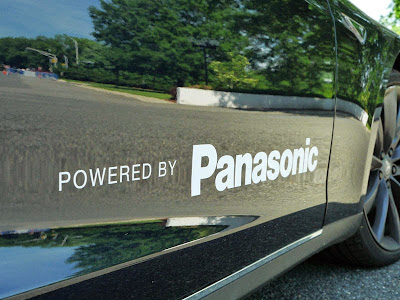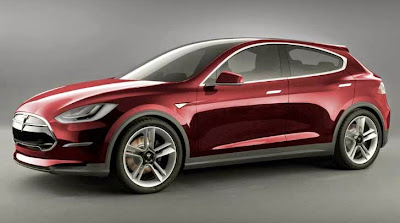CNET On Cars, Episode 46: CNET revisits the Tesla Model S now that it's a bona fide mass production hit.
Panasonic to build gigafactory, produce batteries for Tesla Motors
Japanese electronics giant Panasonic is teaming with Tesla Motors to build batteries for the American electric car manufacturer.
Panasonic is expected to sign a contract this month to help Tesla construct a plant and produce batteries for its vehicles.
Initial operations at the plant are scheduled to commence in 2017 and become fully operational by 2020. The facility will produce batteries for 500,000 vehicles annually.
The American company had been seeking partners for the venture and plans to invest up to $5 billion in the joint project. Panasonic is to be the core participant, likely investing more than 200 million dollars.
Tesla will invest $2 billion in the factory, while the construction will require $4–$5 billion. The rest of the fund will be provided by Tesla’s partners. Tesla is considering other potential investors, such as suppliers of raw materials for the investment.
Panasonic and Tesla signed a deal in Oct 2013, under which Panasonic will increase the supply of battery cells to 2 billion in the 4-year timeframe till 2017. Panasonic has supplied 200 million cells to Tesla in the last 2 years.
In addition, Panasonic doubled its investment for auto batteries to $275 million this year. Panasonic will utilize this additional investment to boost the domestic production of the small lithium-ion batteries for Tesla.
The collaboration ultimately boosted the earnings of Panasonic's lithium-ion battery section into the black for fiscal 2013.
Tesla Motors anticipates selling 35,000 Model S vehicles this year, a 55 percent increase from 2013. The company is also planning to release the Model X, an SUV type electric vehicle, in 2015. The new factory is expected to ultimately boost the number of batteries sold to Tesla Motors.
Panasonic is seeking to increase sales in its EV battery cell sector to 4.5 billion dollars in fiscal 2018. That goal would be a 3.5-fold increase from fiscal 2012.
The company is expanding its battery operations in the hopes of establishing it as a core business. Panasonic's household electronics business previously held that position, but sales have stagnated in recent years.
Tesla’s $35,000 car will be called the Model 3
In an interview with AutoExpress, CEO Elon Musk revealed that the $35,000 vehicle will be called the Model 3 (with three bars to represent it), after Ford put the kibosh on calling it the Model E.
“We were going to call it model E for a while and then Ford sued us saying it wanted to use the Model E".
Musk has repeatedly targeted 2017 as the release window for a smaller vehicle. He's said it will be the third generation after the original Roadster and Model S, and in the interview claims it will have a range of over 200 miles per charge, probably using batteries built in Tesla's planned Gigafactory.
Musk also told the magazine about a range boost upgrade coming for the original Roadster that will give it a modern battery capable of up to 400 miles on a charge, "which will allow you to drive from LA to San Francisco non-stop."
Tesla Model S P85 Dyno Run gets 436 HP @ the wheels [VIDEO]
Tesla owner Emmanuel Chang had his 2013 Black Tesla Model S P85 dyno tested on a mobile CCMR Dynojet recently at some generic car show.
The Model S P85 is officially rated 416 HP at the motor shaft. This particular combination of dyno and P85 recorded 436 HP at the wheels. (there is usually a significant drivetrain loss between motor and wheels)
A few details regarding this test:
Source: TMC
TESLA P85 Vs Electric MIATA – 1/4 mile Drag Race [VIDEO]
A Tesla Model S P85 takes on an Mazda Miata with an Electric Motor Conversion in a 1/4 mile drag race.
The tube frame and tubbed 2002 Mazda Miata runs 2x 2000 amp Zilla 2K-EHV controllers feeding dual brushed DC NetGain 9-inch motors, a Lenco 2 speed and double GV overdrive.
The boot mounted battery pack contains 450x LiPo 100C RC car batteries wired 90S5P that are good for 775 peak battery HP @ 375v. For the record run the controllers were set to 170 volt & 1100 amps per motor.
The Miata runs an incredible 9.27 @ 142 mph to the Tesla's very respectable 12.72 @ 102 mph.
Telsa Model E To Rival BMW 3 Series On Price
New Model E from Tesla will look to take on the BMW 3-series and Audi A4.
The Tesla Model E is expected to go on sale in 2016. The car’s manufacturer said that the price of batteries will play a role in the car’s cost. It claims that the contruction of a Gigafactory will help ease the price of batteries, reports AutoCar.
Tesla also said that the car will be 20% smaller than the Model S. However, it won’t be completely made out of aluminum like the Models S. The Model E is expected to be priced to compete against other electric car rivals, such as the Audi A4 and the BMW 3-series, AutoCar notes.
Tesla is currently building 600 examples of the Model S each week at its factory in Freemont and expects Model X sales to add significantly to that total. The factory has a theoretical capacity of 500,000 vehicles per year.
Driving Tesla Model S P85 on German autobahn [VIDEO]
Norwegian Tesla owner Bjørn Nyland has uploaded a video demonstrating his Model S at Autobahn speeds.
A Tesla Model S P85 driven at it's maximum speed of 210 km/h (130 mph) has an estimated range of 154 kms (96 Miles)
Having recently returned from Munich I can vouch for the fact that driving at 160 km/h (100 mph) in the fast lane is considered slow, they really do drive at 200 km/h routinely on unlimited sections, yet the road toll is actually lower than in many other countries (including Australia).
Nissan & BMW keen to collaborate with Tesla on Supercharger standards
We recently reported that BMW is keen to collaborate with Tesla on creating possible global vehicle-charging standards, and now Nissan is also interested according to sources.
“It is obviously clear that everyone would benefit if there was a far more simple way for everyone to charge their cars,” said one executive, who declined to be named as the plans are not yet official.
Between them, Nissan, the world’s biggest electric-car manufacturer, BMW and Tesla account for about 80 per cent of the world’s battery electric-car sales.
Tesla has risen from an ambitious San Francisco start-up to account for about a quarter of the world’s electric-car market, and defy naysayers at some of the world’s largest carmakers that said that the vehicles were not commercially viable.
BMW, which has invested heavily in its electric i range, said that it and Tesla were “strongly committed to the success of electro-mobility”, and used their meeting to discuss ways to “further strengthen” the global electric-vehicle market.
BMW was informed of Mr Musk’s patent decision at the Wednesday meeting, but both companies stressed that the meeting’s timing was coincidental.
“Nissan welcomes any initiative to expand the volumes of electric vehicles,” the Japanese manufacturer said. “Nissan is the market leader in EVs and has worked with other manufacturers to help proliferate the technology.”
Source: FT
BMW + Tesla superchargers a strategic move?
On Wednesday Tesla and BMW met, but what specifically was discussed was not published.
“Both companies are strongly committed to the success of electromobility and discussed how to further strengthen the development of electromobility on an international level,” a BMW spokesman said today in a statement.
On Thursday, Tesla CEO Elon Musk said his company has been in talks with BMW and other automakers on the topic of promoting EVs and making better use of its German Supercharger charging stations.
Musk said that Tesla’s intent wasn’t to create a walled garden around it's supercharger network and that the company is more than happy to allow other makers to use its fast chargers.
There are number of preconditions, though. Firstly, other makers’ cars would need to be able to accept the 135kW output of the Supercharger. Secondly, rival manufacturers would have to contribute to some of the capital cost of the fast charging network.
The Germany market for long range EVs has some unique requirements. Not only is Tesla offering a special tune-up so that its Model S is capable of 130 MPH to compete against the local Porsches, BMW,s Mercedes and Audis on Germany’s unrestricted, high-speed autobahns. But the extra aerodynamic load resulting from sustained Autobahn speeds means that a huge network of very high powered (read Fast) EV charging stations is essential for the long range EV market to be viable in Germany.
With BMW, Audi, Porsche & Mercedes all having leaked plans for 400-600km BEVs there will definatly be future demand for a fast charger network in German. Establishing the Tesla fast charger standard in Germany now in partnership with BMW, the undisputed leader in EV investment, could be seen as a strategic move.
If Tesla doesn't build it, then someone else will!






.jpg)